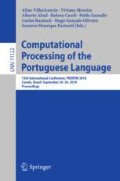Abstract
In Second Language Acquisition (SLA), the exposure of learners to authentic material is an important learning step, but the use of raw text may pose problems, because the information that the learner should be focusing on may be overlooked. In this paper, we present SMILLE for Portuguese, a system for detecting pedagogically relevant grammatical structures in raw texts. SMILLE’s rules for recognizing grammatical structures were evaluated in random sentences from three different genres, achieving an overall precision of 84%. The automatic recognition of pedagogically relevant grammatical structures can help teachers and course coordinators to better inform the choice of texts to be used in language courses, while also allowing for the analysis of grammar profiles for SLA. As a case study, we used SMILLE to analyze pedagogical material used in a Portuguese as foreign language course and to observe how the predominance of grammatical content in the texts is related to the described grammatical focus of the language levels.
Supported by the Walloon Region (Projects BEWARE 1510637 and 1610378) and Altissia International.
Access this chapter
Tax calculation will be finalised at checkout
Purchases are for personal use only
Notes
- 1.
The system is available for testing at https://cental.uclouvain.be/resources/smalla_smille/smille/.
- 2.
Our grammatical structures were based on the course developed by Altissia International (www.altissia.com).
- 3.
SMILLE for Portuguese makes use of the PassPort system [21].
- 4.
We do not present here the 71 rules because many of the grammatical structures are divided along the CEFR levels, presenting some basic content in lower levels and reinforcing them in higher levels, and others are divided in different categories, such as the verb tenses, the comparative forms, the types of adverbs, etc.
- 5.
Selected romances from www.dominiopublico.gov.br.
- 6.
This corpus was compiled in the scope of the project PorPopular (www.ufrgs.br/textecc/porlexbras/porpopular/index.php).
- 7.
Sentences with more than one instance of the selected structure were evaluated only based on the first instance.
- 8.
References
Azab, M., Salama, A., Oflazer, K., Shima, H., Araki, J., Mitamura, T.: An english reading tool as a NLP showcase. In: The Companion Volume of the Proceedings of IJCNLP 2013: System Demonstrations, pp. 5–8. Asian Federation of Natural Language Processing, Nagoya, Japan, October 2013. http://www.aclweb.org/anthology/I13-2002
Azab, M., Salama, A., Oflazer, K., Shima, H., Araki, J., Mitamura, T.: An NLP-based reading tool for aiding non-native english readers. Recent Advances in Natural Language Processing, p. 41 (2013)
Brown, J., Eskenazi, M.: Retrieval of authentic documents for reader-specific lexical practice. In: InSTIL/ICALL Symposium 2004 (2004)
Chinkina, M., Kannan, M., Meurers, D.: Online information retrieval for language learning. In: ACL 2016, p. 7 (2016)
Cross, J.: Noticing’in sla: Is it a valid concept. TESL-EJ 6(3), 1–9 (2002)
Doughty, C.: Second language instruction does make a difference. Stud. Second Lang. Acquisition 13(04), 431–469 (1991)
Manning, C.D., Surdeanu, M., Bauer, J., Finkel, J., Bethard, S.J., McClosky, D.: The Stanford CoreNLP natural language processing toolkit. In: Association for Computational Linguistics (ACL) System Demonstrations, pp. 55–60 (2014). http://www.aclweb.org/anthology/P/P14/P14-5010
Marujo, L., et al.: Porting reap to european portuguese. In: SLaTE, pp. 69–72 (2009)
Meurers, D., et al.: Enhancing authentic web pages for language learners. In: Proceedings of the NAACL HLT 2010 Fifth Workshop on Innovative Use of NLP for Building Educational Applications, pp. 10–18. Association for Computational Linguistics (2010)
Plonsky, L., Ziegler, N.: The CALL-SLA interface: Insights from a second-order synthesis (2016)
Reinders, H.: Towards a definition of intake in second language acquisition (2012)
Schmidt, R.: The role of consciousness in second language learning1. Appl. Linguistics 11(2), 129–158 (1990)
Schmidt, R.: Attention, awareness, and individual differences in language learning. Perspect. Indiv. Characteristics Foreign Lang. Educ. 6, 27 (2012)
Simard, D.: Differential effects of textual enhancement formats on intake. System 37(1), 124–135 (2009)
Smith, M.S.: Input enhancement in instructed sla. Stud. Second Lang. Acquisition 15(02), 165–179 (1993)
Smith, M.S., Truscott, J.: Explaining input enhancement: a mogul perspective. Int. Rev. Appl. Linguistics Lang. Teach. 52(3), 253–281 (2014)
Tiedemann, J.: Finding alternative translations in a large corpus of movie subtitle. In: International Conference on Language Resources and Evaluation (2016)
Truscott, J.: Noticing in second language acquisition: a critical review. Second Lang. Res. 14(2), 103–135 (1998)
Verhelst, N., Van Avermaet, P., Takala, S., Figueras, N., North, B.: Common European Framework of Reference for Languages: Learning, Teaching, Assessment. Cambridge University Press, Cambridge (2009)
Zilio, L., Fairon, C.: Adaptive system for language learning. In: 2017 IEEE 17th International Conference on Advanced Learning Technologies (ICALT), pp. 47–49. IEEE (2017)
Zilio, L., Wilkens, R., Fairon, C.: Passport: a dependency parsing model for portuguese
Zilio, L., Wilkens, R., Fairon, C.: Enhancing grammatical structures in web-based texts. In: Proceedings of the 25th EUROCALL, pp. 839–846, Accepted, 2017
Zilio, L., Wilkens, R., Fairon, C.: Using NLP for enhancing second language acquisition. In: Proceedings of Recent Advances in Natural Language Processing, pp. 839–846 (2017)
Author information
Authors and Affiliations
Corresponding author
Editor information
Editors and Affiliations
Rights and permissions
Copyright information
© 2018 Springer Nature Switzerland AG
About this paper
Cite this paper
Zilio, L., Wilkens, R., Fairon, C. (2018). SMILLE for Portuguese: Annotation and Analysis of Grammatical Structures in a Pedagogical Context. In: Villavicencio, A., et al. Computational Processing of the Portuguese Language. PROPOR 2018. Lecture Notes in Computer Science(), vol 11122. Springer, Cham. https://doi.org/10.1007/978-3-319-99722-3_2
Download citation
DOI: https://doi.org/10.1007/978-3-319-99722-3_2
Published:
Publisher Name: Springer, Cham
Print ISBN: 978-3-319-99721-6
Online ISBN: 978-3-319-99722-3
eBook Packages: Computer ScienceComputer Science (R0)

